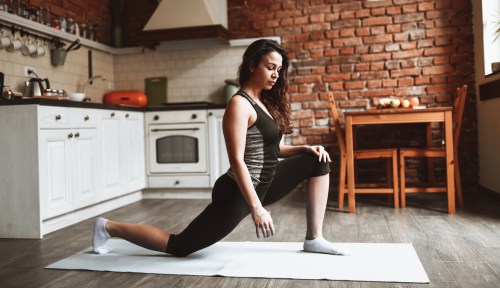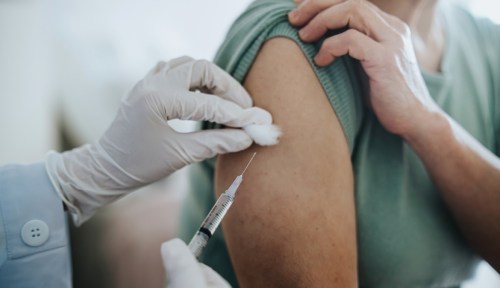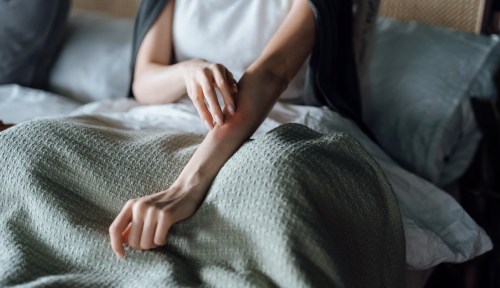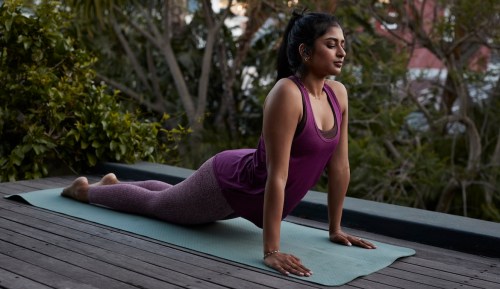Our editors independently select these products. Making a purchase through our links may earn Well+Good a commission
Get Relief From PMS Symptoms With These 4 Gentle Moves
Experts from P.volve share four exercises for PMS that can help you find relief from the worst symptoms—and explain why movement helps.

Anyone who menstruates knows that the hormonal fluctuations of our monthly cycle can wreak havoc on our bodies. In particular, premenstrual syndrome, or PMS, can make you want to never leave your bed. Bloating, abdominal cramps, fatigue, appetite changes, headaches, moodiness, and muscle aches can all hit right before you get your period and have you craving little more than blankets, chocolate, and a Netflix binge.
Experts in This Article
But the truth is, gentle activity can often be the best medicine: “Exercise may feel like the last thing you want to do,” says Amy Hoover, DPT, a physical therapist at P.volve, a physical therapy-inspired functional fitness method for women that designs workouts for each phase of the menstrual cycle. “Learning to move in the right way for your specific needs can be rewarding and not only improve discomfort but also mood and a sense of accomplishment.”
How can exercise alleviate PMS symptoms?
Exactly what causes PMS is unknown. But experts believe it may be due to a drop in hormones—specifically estrogen and progesterone—during the luteal phase of the menstrual cycle, when the body is preparing for the implantation of a fertilized egg. “Stress, nutrient deficiencies, alcohol, caffeine, and high-sodium/processed foods may also exacerbate PMS,” says Maeve McEwen, P.volve’s lead trainer and director of programming.
So what good can a workout do? “Exercise may improve resting cortisol levels, and we know that cortisol contributes to hormonal imbalance,” says Dr. Hoover. “Movement also helps improve blood flow, which can decrease the fullness and bloating.”
Dr. Hoover says that certain types of exercise can also trigger our bodies to relax. “When we don’t feel well, we tend to guard or tense our muscles subconsciously as part of our sympathetic nervous system response,” she says. “Tuning into our body and noticing areas of tension while we move our bodies may improve muscle tension and also help to calm the nervous system.”
McEwen adds that any type of physical activity increases circulation and the body’s production of endorphins. These responses can increase your energy and mood, both of which are often low with PMS. “Prioritizing lower-impact and gentler movements when you are experiencing PMS may also help decrease inflammation, keep your body temperature regulated, and regulate stress levels.”
Gentle exercises and stretches to try
Movements that open the ribs, abdomen, spine, and hips tend to be the most helpful for relieving premenstrual discomfort. “Typically, during PMS, we experience symptoms in the pelvic and abdominal region, and this may lead to tension in this area,” Dr. Hoover explains. “Opening the hips, rotating the spine, relaxing and lengthening in the torso, and practicing deep breathing may help improve the blood flow and alleviate the fullness feeling in the pelvis during PMS.”
She adds that movements that target the neck and shoulders while simultaneously promoting relaxed breathing may also help alleviate the tension headaches often associated with PMS.
Cat cow
McEwen says contracting and lengthening the spine, back muscles, and abdominals can alleviate tension and cramping, and boost circulation.
- Get down on your hands and knees in a tabletop position with a flat back and your core engaged.
- Inhale as you extend through your spine and lengthen through the front body, drawing your chest forward and looking up.
- Exhale and contract through your abdominals as you round your upper spine towards the ceiling, dropping the head and tailbone toward the floor.
- Continue for as many reps and at a speed that works best for your body.
Kneeling lunges
McEwen says this is a great dynamic stretch for relieving PMS symptoms. “Focus on breathing and creating space in your hips,” she says. “This can boost circulation and alleviate excessive gripping or tension.”
- Drop down on one knee, the other foot in front (with knees at right angles) with your torso upright and core tight.
- Squeeze the glute on the rear leg and shift your pelvis forward while reaching overhead.
- Repeat eight to 10 slow reps.
- Then, open your front leg about 45 degrees to the side, and again shift your hips towards that foot, stretching into the inner thighs while reaching overhead.
- Repeat eight to 10 slow reps.
- Don’t forget your second side.
Standing abdominal rotations
“This move can help boost circulation by gently engaging your abdominals and rotating through the back,” notes McEwen.
- Stand tall on one leg, with the other foot pointed in front of you. Squeeze the glute on the leg you’re standing on and reach your arms overhead.
- Inhale as you elongate your abs and chest. Then exhale, bringing your front knee and arms towards the midline of your body while twisting your torso towards the front leg.
- Complete eight to 10 reps.
- Switch sides
Diaphragmatic breathing with lateral reaches
With this exercise, McEwen says to aim to make your exhales longer than your inhales. “This can help tap into a parasympathetic state (‘rest and digest’), calm your nervous system, and thus promote lower cortisol levels,” she explains.
- Sit in a comfortable position, keeping a long, neutral spine. Place your hands around your low rib cage.
- Inhale, expanding your entire belly and rib cage in 360 degrees.
- Exhale slowly without gripping your shoulders, hips, or belly.
- Continue this breathing pattern as you reach your arms straight out to both sides to further create space and relaxation.
Tips for exercising to relieve PMS symptoms
When you’re down for the count with PMS symptoms, you may not feel up to ripping through a hard HIIT class or logging miles on a long run. And that is totally fine.
“Choose movement that matches what you feel for that day. Notice where you are holding tension or where you may feel symptoms, and try to focus your movements in that area,” Dr. Hoover advises. “It may seem counterintuitive to move where you are uncomfortable, but connecting to what you feel and then allowing movement in those areas will actually improve blood flow and ultimately relieve your symptoms.”
Plan to work out at a time when you have the energy to focus and move mindfully. “Generally, keeping the intensity of your workouts on the shorter and gentler side can help mitigate some PMS symptoms and can help prevent a spike in cortisol,” says McEwen.
McEwen also recommends planning your workouts strategically throughout your menstrual cycle, taking advantage of the optimal times to focus on strength, cardio, recovery, etc. depending on your hormonal levels. P.volve’s on-demand series Phase and Function has movement, mindset, meals, and educational tools that were co-created with a registered dietitian and OB-GYN to help you start a cycle-syncing routine. Because the choices you make in one phase may affect how you feel in the next one. “Cycle syncing not only when PMS is present, but throughout the entire cycle, can promote optimal hormone balance, and thus mitigate PMS,” says McEwen.
Oh hi! You look like someone who loves free workouts, discounts for cutting-edge wellness brands, and exclusive Well+Good content. Sign up for Well+, our online community of wellness insiders, and unlock your rewards instantly.
Sign Up for Our Daily Newsletter
Get all the latest in wellness, trends, food, fitness, beauty, and more delivered right to your inbox.
Got it, you've been added to our email list.










